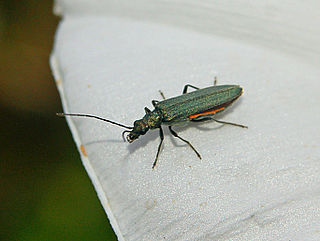
The green heron is a small heron of North and Central America. Butorides is from Middle English butor "bittern" and Ancient Greek -oides, "resembling", and virescens is Latin for "greenish".

The Acadian flycatcher is a small insect-eating bird of the tyrant flycatcher family.

The grapevine beetle, Pelidnota punctata, also known as the spotted June beetle or the spotted pelidnota, is a species of beetle in the family Scarabaeidae, situated in the subfamily Rutelinae. Grapevine beetles are common in the north and central United States and Eastern Canada, but do relatively little damage to their host plants. The beetles fly at a fast speed, usually in a curving flight.

Cactus longhorn beetles are large, flightless, black beetles found in North American deserts of the western United States and northern Mexico. M. gigas is native to the Sonoran desert at elevations below 4900 feet (1500m). The front wings of these beetles are fused forming a single, hardened shell, from which the genus derives its Latin name. The genus includes twenty species.

Cleridae are a family of beetles of the superfamily Cleroidea. They are commonly known as checkered beetles. The family Cleridae has a worldwide distribution, and a variety of habitats and feeding preferences.

Strategus aloeus, the ox beetle, is a species of rhinoceros beetle. The "major" males of this species have three large horns on their thoraces, resembling the Triceratops. The "minor" males have horns, as well, but the two back ones are small and the frontal horn is much shorter than the horn in major males. The female ox beetle has a very short horn which has little use in fighting, but is used for digging in the ground. These beetles grow to about 1.0 to 1.5 in long as adults when the horns are excluded in the males.

Chahuis or xamoes are the common names given in Mexico to a variety of edible beetles within the insect order Coleoptera. The insects' common names in English are often "sticks worms", "rhinoceros beetle," or "grub".
Syntelia is a genus of middle-sized beetles, the only genus in the family Synteliidae.

Heliothis virescens, commonly known as the tobacco budworm, is a moth of the Noctuidae family found throughout the eastern and southwestern United States along with parts of Central America and South America.

Pelidnota burmeisteri is a species of beetles belonging to the Scarabaeidae family.

Oedemera lurida is a species of beetle belonging to the family Oedemeridae subfamily Oedemerinae.

Pelidnota is a genus of beetles belonging to the Scarabaeidae family.

Pelidnota sumptuosa is a species of beetles belonging to the Scarabaeidae family.

Pelidnota kirbyi is a species of beetles belonging to the Scarabaeidae family.

Euthyrhynchus floridanus, the Florida predatory stink bug, is a species of carnivorous shield bug in the family Pentatomidae. It is native to the hottest parts of the southeastern United States and is considered beneficial because it feeds on many species of pest insects.
Sternotomis virescens is a species of beetle in the family Cerambycidae. It was described by Westwood in 1845. It has a wide distribution in Africa. It feeds on Coffea canephora.
Phosphorus virescens is a species of beetle in the family Cerambycidae. It was described by Olivier in 1795, originally under the genus Cerambix. It has a wide distribution throughout Africa.
Rutelini is a tribe of shining leaf chafers in the family Scarabaeidae. There are about 14 genera and at least 40 described species in Rutelini.
Pelidnota lugubris is a species of shining leaf chafer in the family of beetles known as Scarabaeidae.
Sphaeriestes virescens is a species of narrow-waisted bark beetle in the family Salpingidae. It is found in North America.















